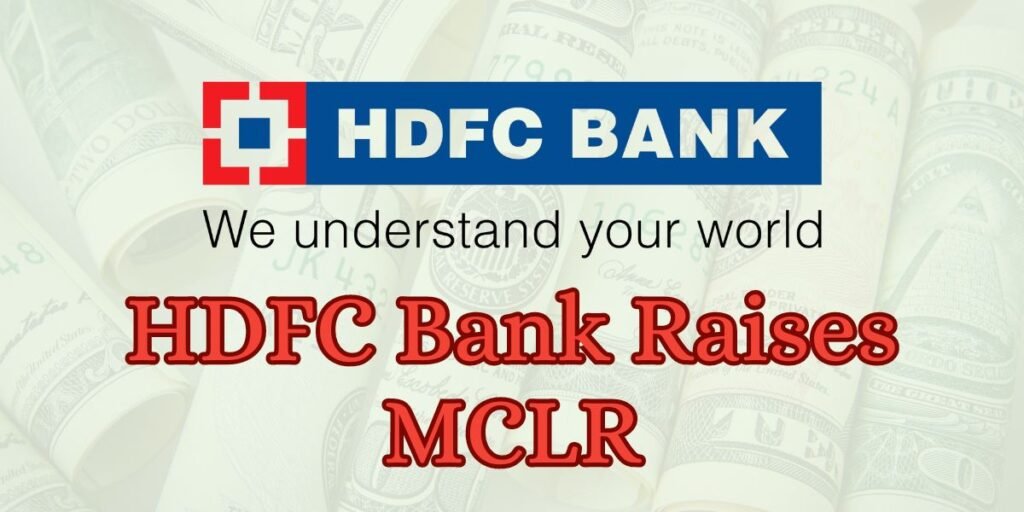In the dynamic landscape of banking, the Marginal Cost of Funds Based Lending Rate (MCLR) serves as a pivotal factor in determining interest rates. HDFC Bank, a key player in the financial sector, recently made a decision that sent ripples through the market by increasing its MCLR. This move directly impacts consumers and their existing loans, ushering in a wave of changes in the realm of Equated Monthly Installments (EMIs).
HDFC Bank’s Perspective: Official Statements and Communications
After the recent adjustment, HDFC Bank’s Marginal Cost of Funds Based Lending Rate (MCLR) now ranges from 8.65 percent to 9.30 percent. Here you can easily check the rates:
- MCLR Range:
- Ranges from 8.65% to 9.30%
- Overnight MCLR:
- Increased by 0.05% to 8.65%
- Previous Rate: 8.60%
- This adjustment reflects a slight upward shift in short-term lending rates.
- One-Month MCLR:
- Increased by 0.05% to 8.70%
- Previous Rate: 8.65%
- The one-month MCLR has experienced a similar 0.05% increase, aligning with the overnight rate adjustment.
- Three-Month MCLR:
- Adjusted upward to 8.90%
- Previous Rate: 8.85%
- The three-month MCLR has seen a moderate increase, indicating an adjustment in the medium-term lending rates.
- Six-Month MCLR:
- Incremented to 9.15%
- Previous Rate: 9.10%
- The six-month MCLR has been raised, signaling a shift in rates for a slightly longer term.
- One-Year MCLR:
- Remains unchanged at 9.20%
- Notably, a significant portion of loans is tied to the one-year MCLR, and its stability suggests no immediate change in longer-term lending rates.
- Two-Year and Three-Year MCLR:
- Revised upward from 9.25% to 9.30%
- The MCLR for two and three years has been adjusted upwards, impacting longer-term lending rates.
Economic Factors Contributing to MCLR Change
Certainly, let’s dive into the economic factors contributing to the recent MCLR change at HDFC Bank.
In the intricate realm of banking, the Marginal Cost of Funds Based Lending Rate (MCLR) is intricately linked to various economic indicators. HDFC Bank’s decision to increase MCLR reflects a response to the dynamic conditions in the broader economic landscape.
One of the pivotal economic factors influencing MCLR is inflation:
As inflation rates fluctuate, they exert pressure on the overall cost of funds for banks. A spike in inflation often prompts banks to reevaluate their lending rates, aligning them with the prevailing economic conditions.
GDP growth is another critical factor:
A robust and growing economy tends to correlate with higher interest rates. HDFC Bank, as a prudent financial institution, likely considered the trajectory of the country’s GDP growth when adjusting its MCLR.
Market liquidity conditions also play a role:
When liquidity is scarce, banks may face challenges in sourcing funds at lower costs, prompting them to adjust MCLR accordingly. HDFC Bank’s decision could be a strategic response to maintain financial stability in the face of evolving market liquidity.
Expert opinions from economists and financial analysts further amplify the understanding of these economic factors:
By considering a range of perspectives, HDFC Bank can align its MCLR with informed insights, ensuring a balanced and responsive approach to the economic landscape.
Navigating the Impact on EMIs
Correlation Between MCLR and EMIs
The heart of the matter lies in establishing a clear correlation between MCLR and EMIs. HDFC Bank’s decision to raise MCLR directly influences the interest rates on existing loans. This, in turn, impacts the monthly installment amounts that borrowers are obligated to pay.
Given that the Marginal Cost of Funds Based Lending Rate (MCLR) is directly tied to your loan, any upward adjustment in MCLR directly influences your Equated Monthly Installment (EMI). Consequently, with each increase in MCLR, your EMI will also witness a corresponding rise.
Practical Examples Illustrating EMI Changes
To demystify the impact on EMIs, let’s consider practical examples. For various types of loans such as home loans, personal loans, or car loans, we’ll illustrate how the MCLR increase translates into tangible changes in monthly repayment amounts. This provides borrowers with a concrete understanding of the financial adjustments they might encounter.
Tips for Managing Increased EMIs
Empowering consumers to navigate these changes, practical tips for managing increased EMIs will be outlined. This includes budgeting strategies, potential negotiation tactics, and advice on proactive financial planning. By offering actionable insights, borrowers can approach the situation with a sense of control and preparedness.
